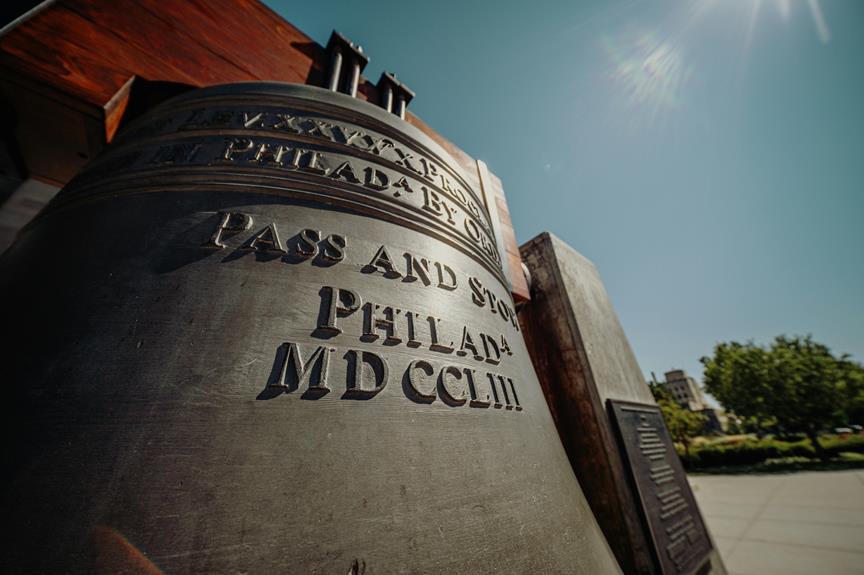The Anne Frank House in Amsterdam, Netherlands, stands as a solemn tribute to a dark chapter in human history. Stepping into the preserved space where Anne Frank and her family sought refuge during the Holocaust evokes a somber reflection on the resilience and strength displayed amidst adversity. As visitors navigate the museum's exhibits and immerse themselves in Anne's poignant diary entries, they are confronted with a profound exploration of the human spirit in the face of unimaginable hardship. The lasting impact of Anne's story lingers within the walls of this historical site, inviting contemplation on the enduring relevance of her message in today's world.
Key Takeaways
- Anne Frank House in Amsterdam preserves WWII history.
- Visit the museum for Anne Frank's story and artifacts.
- Offers guided tours and personal stories for immersive experience.
- Features multimedia presentations and educational programs.
- Provides virtual tour options for global accessibility.
Historical Background
What events and circumstances led to the establishment of the Anne Frank House in the Netherlands? The historical background of the Anne Frank House is deeply rooted in the tragic events of World War II (WWII) history, particularly the persecution of Jewish people during that time. The house gained significance due to its connection to Anne Frank, a young Jewish girl who documented her experiences hiding from the Nazis during the war in her now-famous diary.
During WWII, the Nazi regime under Hitler targeted Jewish people, leading to widespread discrimination, violence, and ultimately, the Holocaust. Anne Frank and her family went into hiding in Amsterdam to escape persecution, residing in a hidden annex of the building where the Anne Frank House is now located. Their harrowing tale of survival, mixed with moments of hope and resilience, captured the world's attention following the publication of Anne's diary.
After the war, Anne's father, Otto Frank, who was the only family member to survive, decided to preserve the annex as a museum to honor Anne's memory and educate future generations about the horrors of the Holocaust and the importance of tolerance. Therefore, the Anne Frank House was established, serving as a poignant reminder of the atrocities of WWII and the resilience of those who suffered during that dark period in history.
Location and Opening Hours
The Anne Frank House, a historical site deeply connected to the events of World War II, is located in Amsterdam, Netherlands, at Prinsengracht 263-267. The house preserves the memory of Anne Frank, a young Jewish girl who documented her life in hiding during the Nazi occupation. It stands as a reminder of the atrocities of the Holocaust and the importance of tolerance and understanding.
The operating schedule of the Anne Frank House varies throughout the year. From November to March, the museum is open every day from 9:00 a.m. to 7:00 p.m., except on Saturdays when it closes at 9:00 p.m. During the rest of the year, from April to October, the museum extends its opening hours, welcoming visitors from 9:00 a.m. to 10:00 p.m. every day, except on Saturdays when it closes at 9:00 p.m.
Visitors should note that the Anne Frank House is closed on Yom Kippur, a significant Jewish holiday, as well as on December 25th and January 1st. Additionally, it is recommended to book tickets in advance due to the museum's popularity. The Anne Frank House provides a profound and educational experience, allowing visitors to reflect on the past and contemplate the importance of human rights and equality.
Anne Frank's Life Story
Anne Frank's life story unfolds as a poignant narrative of resilience and courage amidst the harrowing backdrop of World War II. Born in Frankfurt, Germany, Anne and her family fled to Amsterdam to escape Nazi persecution. During their time in hiding from 1942 to 1944, Anne kept a diary where she poured out her thoughts, fears, and reflections. Her diary entries not only captured the daily struggles of living in confinement but also reflected her profound wisdom and hope for a better future.
The discovery of the hiding place where Anne and her family were sheltered, known as the Secret Annex, is a pivotal moment in Anne Frank's story. In August 1944, the group was betrayed and arrested by the Nazis. Anne and her sister Margot were eventually transported to the Bergen-Belsen concentration camp, where they both tragically perished just weeks before the camp's liberation.
Despite the immense challenges she faced, Anne Frank's spirit and resilience continue to inspire people worldwide. Her diary, published posthumously as 'The Diary of a Young Girl,' remains a powerful affirmation to the human spirit in the face of adversity. Visiting the Anne Frank House in Amsterdam provides a profound opportunity to reflect on Anne's life, her diary reflections, and the enduring importance of never forgetting the lessons of history.
The Secret Annex
Located in Amsterdam, the Secret Annex served as the hidden refuge where Anne Frank and her family sought shelter during the tumultuous years of World War II.
- Symbol of Resilience: The Secret Annex symbolizes the resilience of the human spirit in the face of adversity, showcasing how the Frank family coped with the challenges of living in hiding for over two years.
- Discovery of the Annex: The Secret Annex remained concealed for a significant period until it was betrayed, leading to the arrest of the occupants by the Nazi authorities.
- Hiding in Plain Sight: Despite the constant fear of discovery, Anne Frank and her family managed to live in the Secret Annex for an extended period, relying on the help of trusted individuals to sustain their concealment.
- Legacy of the Annex: The Secret Annex stands as a poignant reminder of the horrors of war and the enduring importance of upholding freedom and human rights, inspiring visitors to reflect on the past and work towards a better future.
The Secret Annex, a place of both refuge and fear, encapsulates the harrowing experiences of the Frank family during their time in hiding, ultimately serving as a powerful educational tool for present and future generations to understand the impact of intolerance and the significance of preserving freedom.
Exhibits and Artifacts
Numerous exhibits and artifacts within the Anne Frank House offer a profound glimpse into the daily lives and struggles of those who sought refuge in the Secret Annex during World War II. The museum showcases a range of personal belongings that belonged to Anne Frank and the other occupants, providing visitors with a tangible connection to the past. From Anne's actual diary to clothing items and photographs, these artifacts humanize the historical accounts and make the experience more poignant.
An integral part of the exhibits is the interactive displays that engage visitors of all ages. Through multimedia presentations, visitors can immerse themselves in the stories of the people who lived in hiding, gaining a deeper understanding of the challenges they faced. These interactive elements create a dynamic and educational environment, allowing visitors to explore the history in a hands-on way.
To provide a clearer overview, the following table outlines some of the key exhibits and artifacts found within the Anne Frank House:
| Artifact | Description |
|---|---|
| Anne's Diary | The original diary where Anne Frank documented her thoughts and fears |
| Clothing items | Various articles of clothing worn by the occupants of the Secret Annex |
| Photographs | Images capturing moments of joy and reflection during their confinement |
| Household items | Everyday objects used by the residents, preserving a sense of normalcy |
These exhibits and artifacts collectively form a powerful narrative that educates and inspires visitors about the importance of remembrance and understanding in the face of adversity.
Visitor Experience
The immersive visitor experience at the Anne Frank House offers a thorough journey into the lives of those who lived in hiding during World War II. Visitors are taken on a guided tour through the secret annex where Anne Frank and her family lived, providing a glimpse into the daily struggles and triumphs of those in hiding. To enhance the visitor experience, the museum incorporates the following elements:
- Interactive Activities: Throughout the tour, visitors have the opportunity to engage in interactive activities that deepen their understanding of the historical context and personal experiences of the Frank family. These activities serve to educate and provoke thoughtful reflection on the impact of war and discrimination.
- Guided Tours: Knowledgeable guides lead visitors through the museum, offering insights and information about the history of the Holocaust, the Frank family, and the significance of Anne's diary. These tours provide a structured and informative way to explore the exhibits and artifacts within the museum.
- Personal Stories: The visitor experience is enriched by the personal stories shared throughout the tour, highlighting individual experiences and showcasing the resilience and courage of those affected by the Holocaust.
- Multimedia Presentations: The museum utilizes multimedia presentations to bring the history of Anne Frank to life, incorporating photographs, videos, and audio recordings to create a thorough and engaging experience for visitors.
Educational Programs
An array of educational programs is offered at the Anne Frank House to further deepen visitors' understanding of the historical significance and impact of Anne Frank's story during the Holocaust. Interactive workshops are designed to engage participants in meaningful discussions and activities that explore themes such as prejudice, discrimination, and the importance of standing up against injustice. These workshops allow visitors to connect with Anne Frank's diary on a deeper level, fostering empathy and critical thinking skills.
Educational resources at the Anne Frank House provide valuable tools for teachers and students to explore this period of history. Materials such as lesson plans, documentary films, and online exhibitions offer a thorough understanding of the Holocaust and its relevance in today's world. These resources encourage reflection on the past and prompt discussions on human rights, tolerance, and the consequences of intolerance.
Virtual Tour Options
For those unable to visit the Anne Frank House in person, the virtual tour options provide an immersive and informative experience that allows users to explore the historical site from anywhere in the world. The virtual tour offers an interactive experience where users can engage with the history of Anne Frank and gain a deeper understanding of the events that unfolded during World War II.
Here are some key features of the virtual tour:
- 360 Degree Views: Users can enjoy panoramic views of the Anne Frank House, allowing them to virtually navigate through the various rooms where Anne Frank and her family hid during the war. This feature provides a thorough exploration of the annex, offering a detailed look at the living conditions and the challenges faced by its inhabitants.
- Immersive Storytelling: The virtual tour incorporates immersive storytelling techniques, bringing Anne Frank's diary to life through multimedia elements such as videos, audio clips, and interactive displays. This approach helps users connect emotionally with Anne's story and the historical significance of the house.
- Historical Context: Through the virtual tour, users can access additional historical information, photographs, and documents that contextualize Anne Frank's life and the Holocaust. This feature enhances the educational value of the tour, providing a detailed overview of the events surrounding Anne Frank's diary.
- Remote Accessibility: The virtual tour offers remote accessibility, allowing users from around the globe to visit the Anne Frank House at any time. This feature ensures that individuals who are unable to travel to Amsterdam can still experience the rich history of the house and learn about its importance in the context of World War II.
Ticket Information
Exploring the ticket information for the Anne Frank House visit is essential for planning a visit to this historically significant site. Ticket availability for the Anne Frank House can vary depending on the time of year and demand. It is advisable to book tickets in advance, especially during peak tourist seasons, to secure entry to this popular attraction.
Ticket prices for the Anne Frank House also differ based on age groups, with discounts often available for children, students, and seniors. Pricing information can be found on the official website of the Anne Frank House, where visitors can also explore any ongoing promotions or special offers.
Online reservations are recommended for those planning a visit to the Anne Frank House. Booking tickets online not only guarantees entry but also allows visitors to skip the queue at the ticket counter, saving valuable time during their visit. Additionally, online reservations may offer discounts or package deals that are not available for on-the-spot ticket purchases.
Support and Donation Opportunities
Considering the historical significance and ongoing preservation efforts of the Anne Frank House, visitors have the opportunity to contribute to its mission through various support and donation opportunities available. Supporting this important institution guarantees that the legacy of Anne Frank and the lessons of the Holocaust continue to be shared with future generations. Here are some ways visitors can get involved:
- Fundraising Campaigns: The Anne Frank House frequently organizes fundraising campaigns to gather support for its educational programs, maintenance of the museum, and preservation of historical artifacts. By donating to these campaigns, individuals can directly impact the sustainability of this significant institution.
- Volunteer Opportunities: Those looking to contribute their time and skills can explore volunteer opportunities at the Anne Frank House. Volunteers play a critical role in guiding visitors, assisting with educational activities, and supporting various museum initiatives.
- Donation Boxes: Throughout the museum, visitors will find donation boxes where they can make on-the-spot contributions to support the Anne Frank House. Every donation, no matter how small, helps in the maintenance and development of the museum.
- Online Donations: The Anne Frank House website provides a convenient platform for online donations. Visitors can choose to make one-time donations or set up recurring contributions to support the museum's long-term goals.
Frequently Asked Questions
Are There Any Special Events or Exhibitions Held at the Anne Frank House?
Educational workshops and film screenings are common components of many cultural institutions seeking to engage and educate visitors. These events provide opportunities for deeper exploration of historical events, themes, and personal stories.
Workshops offer hands-on learning experiences, while film screenings present visual narratives that can evoke emotional responses and facilitate discussions.
Both types of activities contribute to a more thorough understanding of the subject matter, enhancing the overall visitor experience.
Can Visitors Interact With Any Virtual Reality Experiences at the Museum?
Visitors at the museum can immerse themselves in dynamic virtual reality experiences, offering a unique interactive journey through historical events. Interactive displays further enhance the visitor experience, fostering a deeper understanding of the subject matter.
These engaging elements provide an innovative way for guests to connect with the past and gain valuable insights. The incorporation of virtual reality technology adds a modern dimension to the museum experience, making it both educational and enthralling.
Is There a Specific Age Restriction for Visiting the Anne Frank House?
Age restrictions are common in many cultural institutions to guarantee the appropriateness of content and the overall experience for visitors. Guided tours may have specific age requirements to cater to the maturity level and attention span necessary to engage with the information provided.
These restrictions are in place not to exclude, but to enhance the learning environment and ensure that visitors can fully appreciate and comprehend the historical significance of the site.
Are There Any Volunteer Opportunities Available at the Museum?
Exploring the world of cultural institutions often reveals a treasure trove of volunteer opportunities. Museums, with their rich tapestries of history and art, frequently beckon individuals seeking to contribute their time and passion.
Museum programs provide a platform for volunteers to engage with visitors, assist in organizing events, and support educational initiatives. These opportunities not only enrich the museum experience but also foster a sense of community and shared heritage among participants.
Can Visitors Purchase Authentic Replicas of Artifacts From the Museum Gift Shop?
Visitors often seek to purchase replica souvenirs as mementos from museum gift shops. Authentic artifacts hold an educational and sentimental value, prompting interest in owning similar items.
The availability of such replicas in gift shops allows visitors to bring a piece of their museum experience home. Offering carefully crafted replicas of artifacts provides a tangible connection to the historical significance of the museum, enhancing the overall visitor experience.
Conclusion
To sum up, the Anne Frank House in the Netherlands stands as a powerful evidence to the horrors of World War II and the resilience of the human spirit.
Through its exhibits, artifacts, and educational programs, the museum allows visitors to immerse themselves in Anne Frank's story and reflect on the importance of tolerance and standing up against injustice.
A visit to the Anne Frank House is a moving and educational experience that leaves a lasting impact on all who enter its doors.


